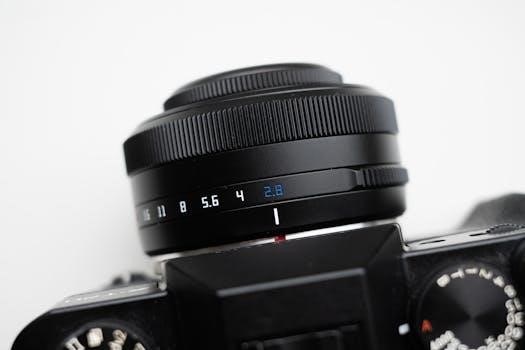The Schiit Modi 3 is designed to enhance audio from computers, sound cards, tablets, and mobile devices. Its versatile input options also allow pairing with CD players, game consoles, and other devices. This simple DAC supports PCM replay via three manually switched inputs.
Overview of the Schiit Modi 3 DAC
The Schiit Modi 3 is a digital-to-analog converter (DAC) that serves as a replacement for previous models, the Modi 2 and Modi 2 Uber. This device aims to improve audio quality by externalizing sound processing from devices like computers. It features three input options⁚ USB, S/PDIF, and Toslink, which allows for versatile connectivity. The Modi 3 is designed for simple PCM replay with manually switched inputs. It is a compact and affordable solution, and is often lauded for its value proposition. It is targeted towards users seeking upgraded audio without excessive complexity. Moreover, its ease of use makes it a practical addition to any audio setup.

Schiit Modi 3 Features
The Schiit Modi 3 boasts multiple input options, including USB, coaxial, and optical. It supports various sample rates and bit depths. The device utilizes the AK4490 DAC chip and OPA1662 op-amps for audio processing.
Digital Input Options⁚ USB, Coaxial, and Optical
The Schiit Modi 3 provides users with a variety of digital input options to accommodate different audio sources. It features a USB input, utilizing Schiit’s own Unison USB interface for a reliable connection to computers, streamers, tablets, or phones. Additionally, the Modi 3 includes both coaxial and optical (Toslink) S/PDIF inputs, allowing it to connect with CD players, game consoles, and other AV devices. These three input options are manually switchable, giving users flexibility in choosing their desired source. The inclusion of these multiple inputs makes the Modi 3 a versatile DAC, suitable for a wide range of audio setups. These options make it easy to integrate into various audio systems.
Supported Sample Rates and Bit Depths
The Schiit Modi 3 supports a range of sample rates and bit depths, ensuring compatibility with various audio formats. Through its USB, coaxial, and optical inputs, the Modi 3 can handle sample rates from 16-bit/44.1kHz up to 24-bit/192kHz. This capability allows for the playback of high-resolution audio files, providing a more detailed and nuanced listening experience. The consistent support for these sample rates and bit depths across all inputs ensures that the user can enjoy the full potential of their digital audio sources, regardless of the chosen connection method. This wide compatibility makes the Modi 3 a versatile option for various setups and preferences in digital audio playback, catering to a broad audience.
DAC Chip and Components⁚ AK4490 and OPA1662
The Schiit Modi 3 utilizes the AKM AK4490 digital-to-analog converter (DAC) chip as its core component for audio processing. This DAC chip is known for its high performance and ability to deliver clean and detailed sound. Complementing the AK4490 is the use of OPA1662 operational amplifiers (op-amps). These op-amps play a critical role in the analog summing and active filtering stages of the audio signal path. The combination of the AK4490 DAC chip and OPA1662 op-amps is carefully chosen to optimize the audio output. This design provides a balanced and accurate sonic performance. Schiit’s choice of components reflects their commitment to high-quality audio reproduction in a compact form factor. These components contribute to the overall sound quality and clarity.

Schiit Modi 3 Performance
The Schiit Modi 3 is known for its well-rounded and balanced sound. It provides a detailed audio experience with full and well-defined bass. It also offers excellent technical performance, making it a highly regarded DAC.
Sound Quality and Characteristics
The Schiit Modi 3 is recognized for its balanced and rounded sound profile, ensuring a pleasant listening experience. The bass is notably full while maintaining excellent definition and control. It is capable of delivering detailed audio, making it suitable for various music genres and listening preferences. The Modi 3 aims to provide a neutral sound signature, avoiding any unnatural coloration. This allows for an accurate representation of the source material. Its sonic characteristics highlight clarity and precision, contributing to an overall enjoyable and immersive audio performance. This makes it a versatile option for those seeking quality sound reproduction without breaking the bank.
Technical Measurements and Performance
The Schiit Modi 3 boasts impressive technical performance, demonstrating Schiit’s commitment to quality. The device has been tested using advanced Audio Precision equipment, showcasing its superior metrics compared to previous Schiit DAC models. It excels in providing a clean and accurate signal, with minimal distortion and noise. The Modi 3 supports sample rates from 16/44.1 to 24/192 via USB, Coaxial, and Optical inputs. It also employs the AK4490 DAC chip and OPA1662 op-amps, contributing to its high fidelity output. Measurements indicate its ability to deliver a precise and transparent audio signal, solidifying its position as a high-performing DAC in its price range.

Schiit Modi 3 Usage
Connecting the Modi 3 is straightforward, allowing for easy integration with various devices. It can be powered via USB or a wall adapter and supports RCA analog output for connection to amplifiers or receivers.
Connecting to Different Devices
The Schiit Modi 3 offers versatile connectivity, allowing it to interface with a wide array of devices. You can connect it to computers, streamers, tablets, or phones via USB, utilizing Schiit’s Unison USB interface for optimal performance. Additionally, the Modi 3 supports optical and coaxial digital inputs, which are suitable for pairing with CD players, game consoles, and other AV equipment. When using these non-USB inputs, the included wall power supply is needed. Simply select your desired input using the front toggle switch. The analog output is via standard RCA connections, allowing easy hookup to amplifiers, preamps, or receivers. This makes the Modi 3 a highly adaptable component for various audio setups.
Powering the Modi 3
The Schiit Modi 3 offers flexible powering options to accommodate various setups. When connected via USB, it can draw power directly from the host device, simplifying setup and minimizing cable clutter. However, when utilizing the coaxial or optical digital inputs, the Modi 3 requires an external power source. Schiit provides a 5V USB wall adapter specifically for this purpose. This adapter ensures a stable and clean power supply, optimizing the DAC’s performance when not powered through USB. Whether using a computer or other devices, the Modi 3’s dual powering method ensures consistent operation. This design provides users flexibility in their setup and avoids limiting the device solely to computer connections.

Schiit Modi 3 Evolution
The Modi 3 replaced the Modi 2 and Modi 2 Uber, offering three inputs⁚ USB, S/PDIF, and Toslink. The Modi 3E is a later update featuring an ESS ES9018 chip, replacing the AKM chip.
Comparison with Previous Modi Versions (2 and 2 Uber)
The Schiit Modi 3 represents a significant upgrade over its predecessors, the Modi 2 and Modi 2 Uber. Unlike the Modi 2 which primarily focused on USB input, the Modi 3 introduces expanded connectivity with the addition of S/PDIF coaxial and TOSLINK optical inputs. This provides much greater flexibility, allowing the Modi 3 to connect to a broader range of devices beyond just computers. The Modi 2 Uber, while offering some improvements over the base Modi 2, still lacked the input versatility of the Modi 3. The transition to the Modi 3 also brought improved performance metrics, making it a more capable DAC overall. The Modi 3 is a simple DAC supporting PCM replay via these three inputs.
The Modi 3E and its ESS ES9018 Chip
The Schiit Modi 3E is the latest iteration in the Modi line, notable for its implementation of the ESS ES9018 chip. This marks a departure from the AKM DAC chip found in the original Modi 3, due to the unavailability of AKM chips after a factory fire. The Modi 3E retains the versatile input options of its predecessor, including USB, coaxial, and optical inputs, but it leverages the ESS ES9018 to deliver a different sonic signature. Schiit has branded this version as a ‘do-all DAC’ due to the versatility of its inputs and their own Unison USB interface. The Modi 3E provides a different approach to digital-to-analog conversion.
Schiit Modi 3 Value and Warranty
The Schiit Modi 3 offers an affordable entry into high-quality audio, providing excellent value for its price. Schiit Audio backs its products with a 2-year limited warranty, covering defects in materials and workmanship.
Affordability and Value Proposition
The Schiit Modi 3 is positioned as a highly affordable DAC, offering significant improvements in audio quality compared to standard built-in solutions. Priced at $99, it provides a substantial upgrade for those seeking better sound from their computers or other digital sources. It’s designed to be a versatile and cost-effective option, delivering performance that rivals more expensive devices. The Modi 3 is a strong value proposition, as it aims to provide high-quality audio without a steep price tag. This makes it accessible to a broad range of users looking to enhance their audio experience without breaking the bank, delivering great performance.
Schiit Audio’s 2-Year Limited Warranty
Schiit Audio provides a 2-year limited warranty for the Modi 3, assuring original purchasers that the product is free from defects in materials and workmanship. This warranty covers repairs for any defects that arise within two years from the purchase date. Schiit Audio’s commitment to quality is evident through this warranty, offering customers peace of mind regarding their investment. If a covered defect occurs, Schiit Audio will repair the device at no cost to the customer. This warranty demonstrates Schiit Audio’s confidence in their product’s reliability and aims to ensure customer satisfaction by backing the Modi 3 with a solid protection policy.